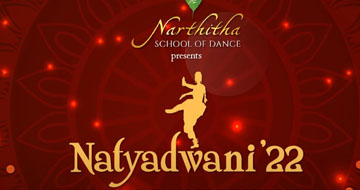Narthitha
School of Dance & Music











Natyadwani 2024 added another feather to the crown of the Narthitha School of Dance, marking the 26th classical dance festival. Held at the Ajman Cultural Center on May 26, 2024, the event featured over 100 dancers who graced the stage, making the show truly grand. Spanning five hours, the festival showcased 28 classical dances. ManojManikkoth, the founder of the Narthitha School of Dance, directed and choreographed this remarkable event..

Natyadwani 2023 marked the 25th classical dance festival organized by the Narthitha School of Dance. Natyadwani 2023, celebrated the rich traditions of classical Indian dance. This prestigious festival brought together accomplished dancers and enthusiastic students for a spectacular display of talent and dedication to classical dance forms. Natyadwani 2023 was a vibrant celebration of classical dance, blending tradition with innovation and bringing together artists and enthusiasts in a shared appreciation of this timeless art form. Organized by the Narthitha School of Dance, it underscored Dubai's growing status as a hub for cultural and artistic expression. Natyadwani 2023, directed and choreographed by ManojManikkoth, the founder of Narthitha School of Dance in Dubai, was a vibrant celebration of classical dance. The festival featured an array of classical dance forms, including Bharatanatyam, Kuchipudi, Mohiniyattam, as well as folk and semi-classical dances. This four-hour event showcased the diversity and richness of Indian classical dance, making it a truly colorful and memorable experience.

Natyadwani 2022 was inaugurated at the Emirates Theatre in Dubai, marking the 24th classical dance festival of the Narthitha School of Dance. This spectacular event was opened by the renowned dance teacher, Mrs. PriyaManoj. It was a wonderful celebration for art lovers, showcasing various Indian classical dance forms. More than 80 dancers graced the stage, making the event truly grand. The show was directed and choreographed by ManojManikkoth, a well-known figure in the field of classical dance.

In this dance drama, we showcased significant portions of the Ramayana, spanning from the birth of Rama to his coronation as king. The Ramayana is one of the two major Sanskrit epics of ancient Indian literature, the other being the Mahabharata. Traditionally attributed to the sage Valmiki, the Ramayana is an epic poem that narrates the life and adventures of Prince Rama, his wife Sita, and his loyal companion Hanuman. The story begins with the birth of Rama, the eldest son of King Dasharatha of Ayodhya. Rama is the incarnation of the Hindu god Vishnu, born to rid the world of the demon king Ravana. After winning Sita's hand in marriage, Rama is exiled to the forest for 14 years due to a promise made by his father to one of his wives. Sita and Rama's loyal brother Lakshmana accompany him. During their exile, Sita is abducted by Ravana, the powerful demon king of Lanka. The central portion of the epic focuses on Rama's quest to rescue Sita. He forms alliances with various beings, most notably the monkey king Sugriva and his general Hanuman, who plays a crucial role in locating Sita and setting the stage for her rescue. The climax of the Ramayana is the great battle between Rama and Ravana, culminating in Ravana's defeat and the rescue of Sita. The epic concludes with Rama, Sita, and Lakshmana returning to Ayodhya, where Rama is crowned king. The Ramayana is not just a story of adventure and heroism; it explores themes of duty, righteousness, loyalty, and the ideal roles of individuals within family and society. It has had a profound influence on the art, culture, and religious life of the Indian subcontinent and beyond. Different versions and adaptations of the Ramayana exist across South and Southeast Asia, each adding unique cultural perspectives to the timeless tale.

The first two lessons, Thattadavu and Nattadavu, have been released. We plan to release the remaining Adavus in the future. Typically, we practice Adavus with sollukettu. However, in these sessions, I've introduced a new method of practicing Adavus with Carnatic music. Dancers experience a unique and enriching feeling when they practice Adavus with Carnatic music. Adavus are the foundational steps in Bharatanatyam, each combining footwork, hand gestures, and specific postures to create intricate patterns of movement. These basic units are essential for mastering the dance form, building strength, rhythm, and coordination.

Manoj Manikkoth Bsc, MFA, MPhil The Performer, Choreographer and a Teacher Narthitha dance academy based in Dubai was founded in the year 2013 with the vision of sharing the beauty and depth of classical dance form, “Bharathanatyam”, the oldest and most widely performed traditional dance of India..